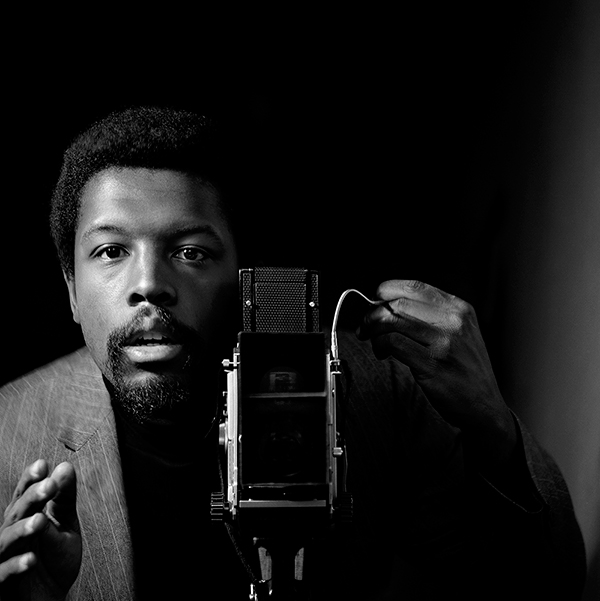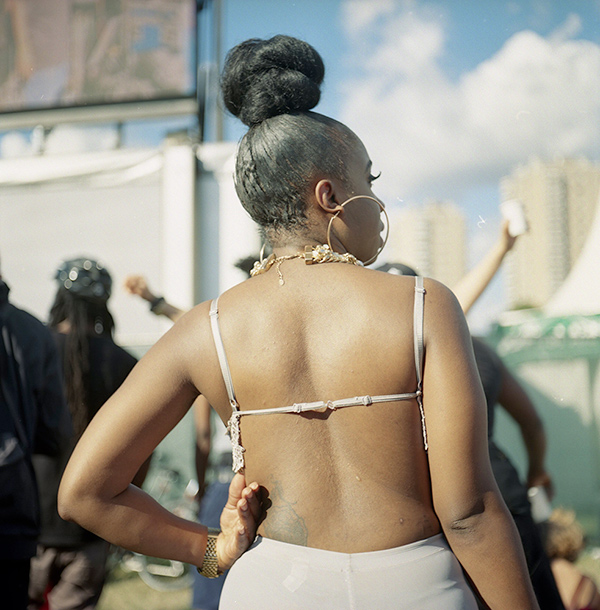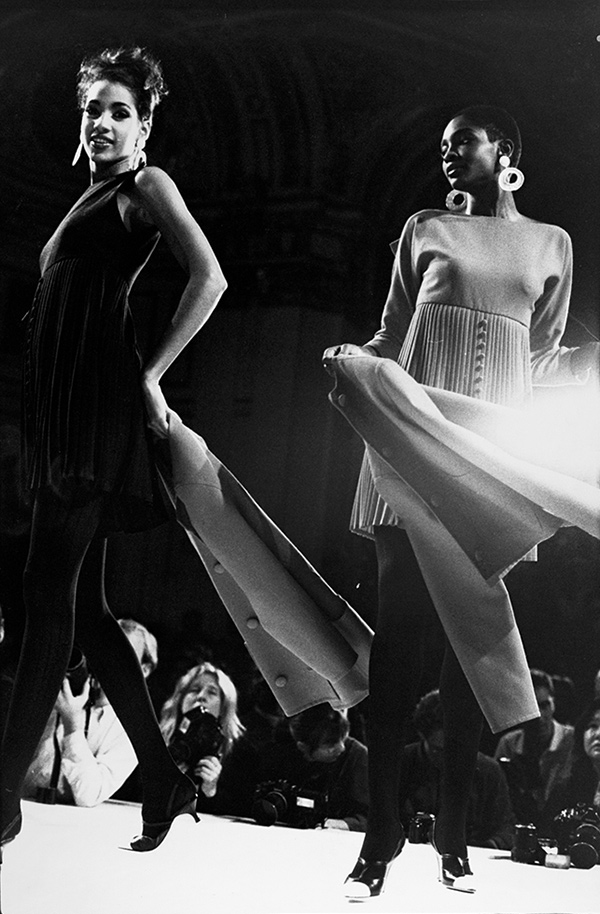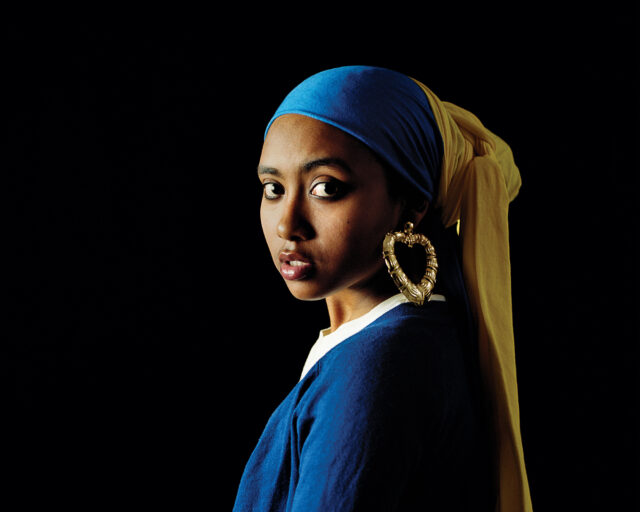Black is Brilliant
From Accra to Harlem, the photographs in an exhibition curated by David Hartt expand the field of representation.

Kwame Brathwaite, Untitled (Self-Portrait), 1964
© the artist, courtesy David Nolan Gallery, New York and Philip Martin Gallery, Los Angeles
What are the images that encapsulate the moments, spaces, communities, and myriad experiences of blackness across the globe? What are the gestures, the glances, the ways of being that illustrate “a crisis of borders, a fold in time, a rupture in space. An assertion of gradience”?
This Synthetic Moment, a group exhibition curated by Canadian artist David Hartt, currently on view at David Nolan Gallery in New York, grapples with such questions, deftly incorporating the work of Russian Ghanaian photographer Liz Johnson Artur, Ghanaian photographer James Barnor, and American photographers Kwame Brathwaite, Zoe Leonard, and Christopher Williams alongside Hartt’s own work. A polyphonic, essayistic installation, the exhibition crisscrosses varied geographies and temporalities, highlighting visions of beauty and style alongside quotidian, melancholic scenes. Spanning six decades, and locations from Accra to Yuzhno-Sakhalinsk, London to New York, it gestures toward an embodied network of visual relations about black identity and subjectivity. Formally, there is a persistent elegance across all images, a grace to the recurring profiles, concealed gazes, open grins, abandoned seascapes. These photographers’ respective pictures are packed with intention, and often signal means of circulation and image making not contingent upon the gallery space. Yet united there, they seem to take a collective breath anew. In dialogue, these works go beyond offering varied visual forms and compositions, and perhaps urge us toward a more iterative, expansive mode of considering black identity and its renderings photographically.

Kwame Brathwaite, Untitled (Sikolo with Carolee Prince Designs), 1968
© the artist, courtesy David Nolan Gallery, New York and Philip Martin Gallery, Los Angeles
Oluremi C. Onabanjo: This Synthetic Moment seems to have been borne of a series of conversations and exchanges, but also equally operated as a site of inquiry when you were at a loss for words. I wonder if you could revisit your conversation with Thomas J. Lax, associate curator at the Museum of Modern Art, which you’ve stated provided you with the seeds of the exhibition’s title?
David Hartt: When I was speaking with Thomas, we were discussing Unfinished Conversations (2017), an exhibition at MoMA that he had worked on and which was on view at the time. I was interested in the show’s proposition, which contained an expanded notion of black identity, beyond national constructs. The exhibition incorporated black voices from a variety of different backgrounds—Black British artists, African American artists, those from the African continent. For me it created a complex understanding of black identity, one that was expansive and complementary. At the moment that I happened upon Unfinished Conversations, I was initially at the museum to see Martine Syms’s Projects 106 (2017) installation. Through viewing her work, a two-hour feature-length film, and then John Akomfrah’s The Unfinished Conversation (2012), I began to recognize not only the conversation that was happening between the two pieces specifically, but also how these images provided a kind of synthesis, in terms of two generations of artists working with film. The concept took root across geography, but also in terms of temporalities.

James Barnor, AGIP Calendar Model, 1974
Courtesy the artist and October Gallery, London
In my own practice, I was also coming to terms with a piece I had just finished, The Last Poet (2017). It’s a film I shot via drone, where I looked at the Eastern Seaboard of the United States. For the film’s narration, I spent two days at Stanford University interviewing Francis Fukuyama, considering the current state of our liberal democracy, and perhaps its decay. Throughout the course of our conversations, the language that he was using was uncompromising and terrifying. It was a very sober, poignant analysis of what we are experiencing. I didn’t know how I would react in the face of this account, but there was a complexity to the emotion that I began to feel, in giving agency to a voice that I wouldn’t necessarily agree with in its entirety. As the piece unfolded, I began to trust myself, and the viewer, knowing that they would be able to use their own values to process the commentary. From there, one thought that endured was the different forms of crisis that we’re experiencing—whether that’s class or race, but also along the lines of unstable borders and shifting political allegiances.
So in combining this experience vested in crisis and the moments of resonance across those two exhibitions, Thomas and I talked through these ideas, trying to find a word to describe them—these permeable boundaries present all around us. Out of that came the “synthetic.”

Liz Johnson Artur, Untitled, 2016
© and courtesy the artist and courtesy David Nolan Gallery, New York
Onabanjo: From the start, This Synthetic Moment has been intertextual, with these manifold references and allusions circling one another, informing its overall structure. This lyrical quality is writ large with the visual rhymes and echoes, but also with regard to the photographers’ biographies, which feed into one another in a manner that is quite organic and fluid. How did you arrive at the various bodies of work that populate the exhibition?
Hartt: The spine of the exhibition is Liz Johnson Artur. I first encountered her work when I was featured in an exhibition with her in Munich, and I remember falling in love with the work as it was presented. I already had her monograph, but it wasn’t until I saw the work presented that I realized its strength. You know, when you put work on display in an exhibition context, it can be quite cold and cut off from the life and the experience of the artist, but with her work, there was a strange, empathetic connection that was sustained. There is this central importance of generosity to her mode of presentation, in which she wants to be able to share, and explore with the viewer as they move through the work. There’s a kind of haptic quality to everything that she does.

Liz Johnson Artur, Untitled, 2016
© and courtesy the artist and courtesy David Nolan Gallery, New York
From there, everything else followed. I was interested in trying to find different voices that could expand on this notion of interrelationships through time, through space, through modes of subjectivity. Christopher Williams and Zoe Leonard came to mind quickly. With Leonard, I was reminded of one of my favorite photographs, Rear View (Geoffrey Beene Fashion Show) (1990), because of its immediacy and its confrontational qualities. So that led me toward an exploration of that body of work, and then I was reintroduced to One Woman Looking at Another (Carolyne Roehm Fashion Show) (1990), and that became another really important image that other lines of inquiry or thinking hinged upon.

Zoe Leonard, One Woman Looking at Another, 1990
Courtesy the artist, Hauser & Wirth, New York and Galerie Gisela Capitan, Germany
With regards to Williams, I was thinking about the photographs of Mustafa Kinte (2007), and in a conversation with Hamza Walker, he introduced me to the work of James Barnor and Kwame Brathwaite. I wasn’t familiar with either of them, but I realized immediately that they allowed me to speak in terms of an expanded geography, as well as an expanded concept of temporality and representation. With Barnor, there was a particular image of a beautiful Ghanaian model surrounded by Agfa chemistry containers, which just rang as a proto-Willliams, especially considering Williams’s darkroom images. The self-portrait of Brathwaite also related very nicely, again as a kind of proto-Williams. So it became a process of going back and forth, each image becoming contingent on another one.

Kwame Brathwaite, Untitled, 1966
© the artist, courtesy David Nolan Gallery, New York and Philip Martin Gallery, Los Angeles
Onabanjo: I’m interested in the different contexts from which these images arrive. Take Kwame Brathwaite and his work with the Grandassa Models and the popularizing of the phrase “Black Is Beautiful,” but also James Barnor’s legacy as the first Ghanaian photographer to use color, photographing Kwame Nkrumah and also working for Drum magazine in London, taking images of these gorgeous cover girls. So having those kinds of fashion and editorial visual vocabularies informing their practices, as well as in the work of Zoe Leonard and Liz Johnson Artur, I wonder how that shapes your understanding of these works living beyond the milieu within which they had circulated, and entering the gallery space together.
Hartt: I interpret these works through the lens of my own education and practice, a photographic one that came at a moment when conceptualism was prioritized. With that, I think what could happen, at least initially, is a sort of instrumentation in terms of how I’m contextualizing Brathwaite and Barnor, because what you’re saying in terms of the origins of their respective practices, and what their agendas were, is definitely outside of this kind of gallery context. So at first, I’m looking through the lens of a Williams or a Leonard, or even myself, in terms of how I understand their work coming together. That being said, I think it’s important to note that the images by Barnor and Brathwaite stand their ground. They change the reading of other images, especially Williams’s portraits of Mustafa Kinte (2007).

Christopher Williams, Mustafa Kinte (Gambia), 2008
© and courtesy the artist and courtesy David Zwirner, New York/London
Williams himself has said those images have been difficult to contextualize and that there is a kind of pressure in terms of addressing how they perform. Therefore, I feel there is a generosity, if you will, by having such portraits then juxtaposed with images by Barnor and Brathwaite. It’s precisely this space where the halo that they grant to Williams’s work is quite important—all of a sudden, the work begins to address subjectivity in a way that is within Williams’s intention, but as a white artist, is perhaps more difficult to make those kinds of requests. So while I recognize the very different kinds of realms in which they operate or were formed in, when brought together here, we begin to kind of appreciate the resonances that these artists’ works share, and grant one another. In having those pieces kind of coexist in the same kind of space, I think, electively, they all benefit.

David Hartt, Interval XIII, 2014
© and courtesy the artist and David Nolan Gallery, New York
Onabanjo: You mentioned in a 2015 interview that “Our understanding of ourselves is deeply rooted in the spaces we occupy.” How do you consider your own work within these associative networks, and within the exhibition?
Hartt: I think that in terms of my own practice, the role that race plays is not immediately apparent. This notion of subjectivity, it’s implicit rather than explicit—perhaps except in the case of Stray Light (2011)—so dealing with the concept of race within the work was something that quite selfishly I wanted to engage. For me, the idea of blackness in my work has everything to do with my ability as a black artist to travel into different communities and cultural expressions, and to represent them in some other way, something typically the domain of white artists. There’s this kind of cultural colonialism that they’ve been able to enjoy, and this sets up a bizarre dichotomy in terms of representation: it’s either the perspective of the white colonizer, or a member of the culture that is being colonized attempting to recognize and depict themselves.
However, I am of the belief that in order for us to understand and learn more about these different positions, they have to be dimensionalized, and by “dimensionalized” I mean that they need to be depicted by more than one, or two—or however many have you—modes of analysis. So simply by my being a black artist engaging with these cultural experiences, I’m adding another dimension in terms of trying to understand what’s present there.

David Hartt, Interval I, 2014
© and courtesy the artist and courtesy David Nolan Gallery, New York
Onabanjo: So there’s a refusal on your part, then. Rather than this being a linear or structured means of outlining representation, you’re offering something more associative, something freer and modular. The viewer can engage with these modes of documentation beyond just straightforward celebration, or just straightforward interrogation.
Hartt: Yes, this notion of subjectivity that we’re talking about has to do with looking at the act of photography and its relationship with these different kinds of subjects in a more complex way. It has to do with providing a latitude in terms of how the photographer operates, and what the photograph can do and what it can say. In that sense, with This Synthetic Moment, it’s vitally important to have somebody like Williams interrogate the idea of black representation, just as it is for Leonard, just as it is for Barnor or Brathwaite, or Johnson Artur. I think what we’re all doing is beginning to expand the fields of representation of this idea of black identity.
This Synthetic Moment is on view at David Nolan Gallery, New York, through March 10, 2018.


























